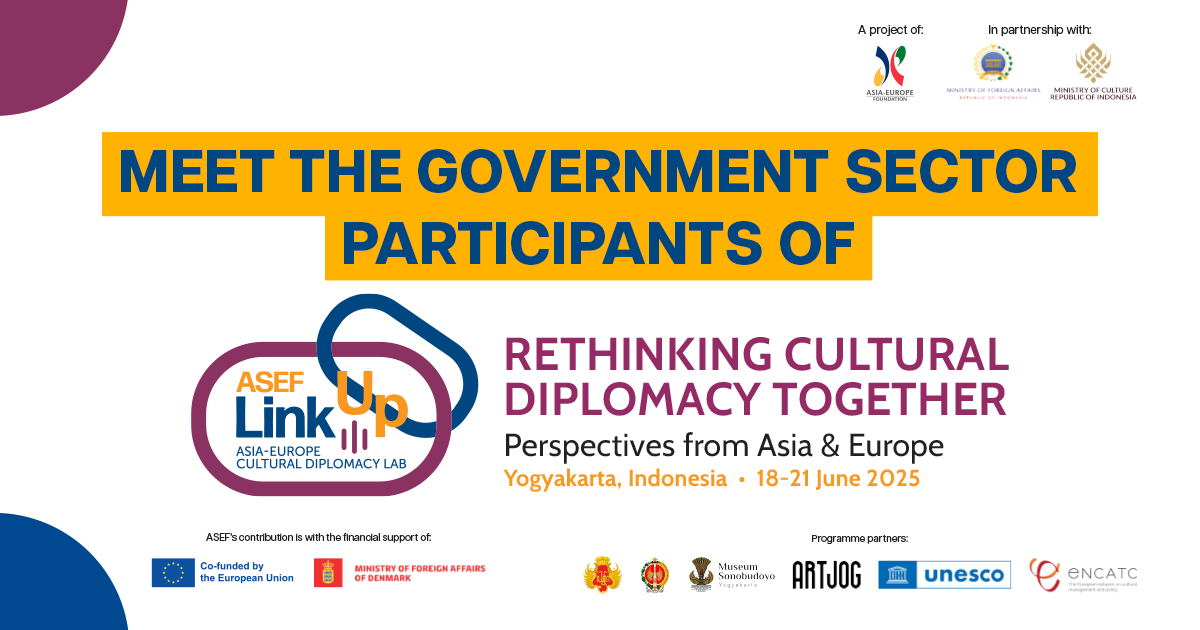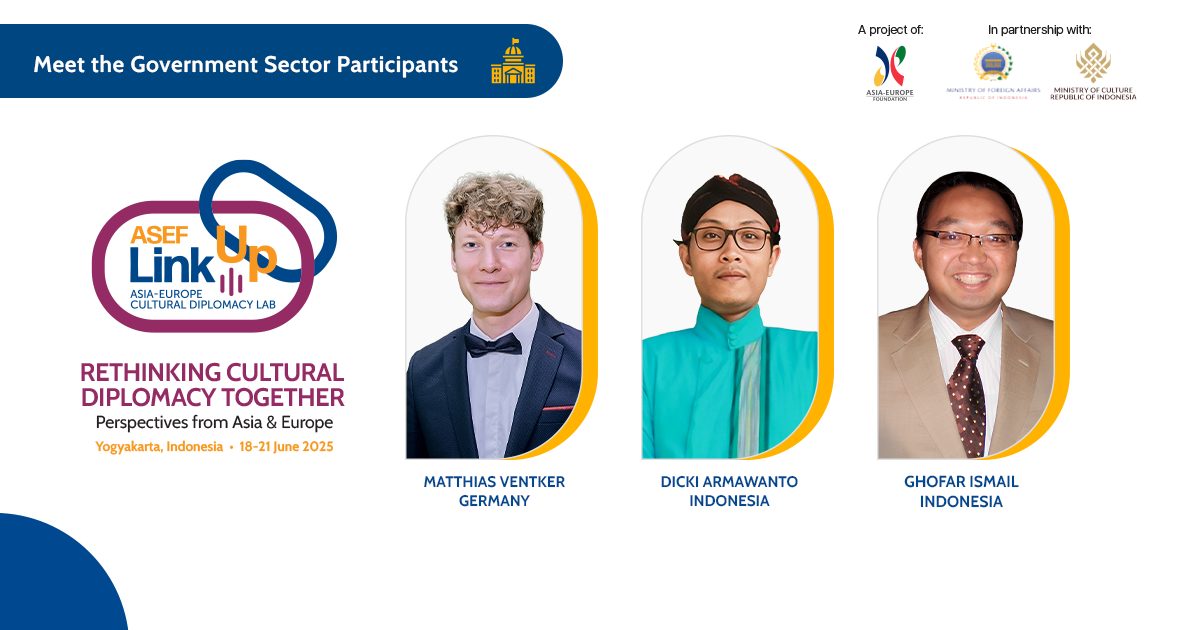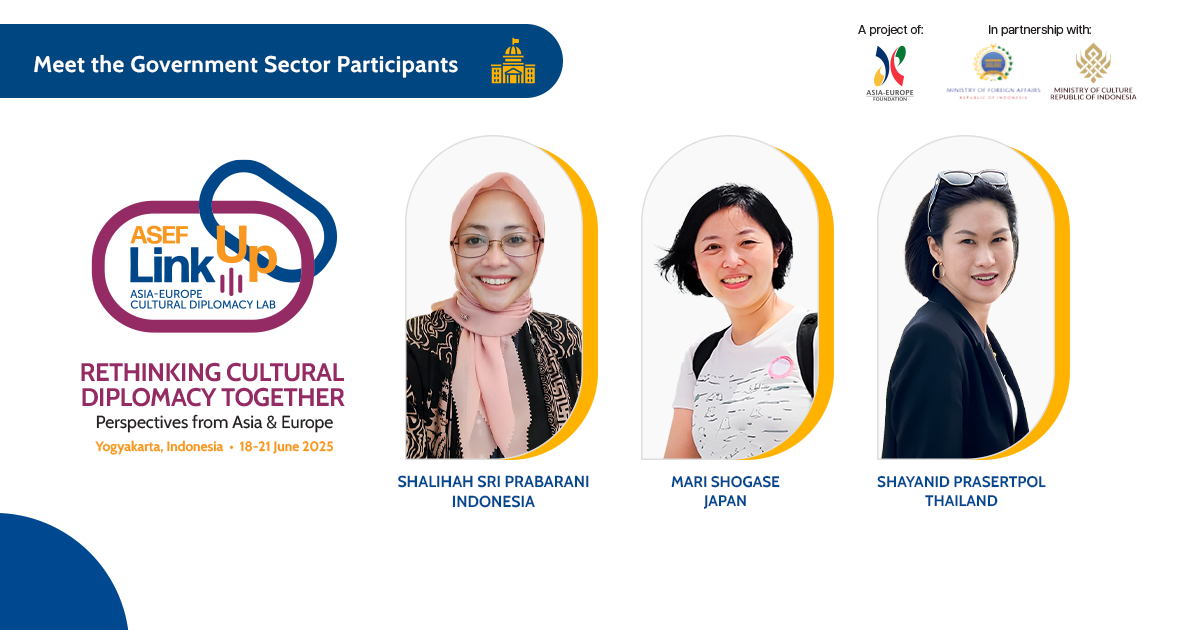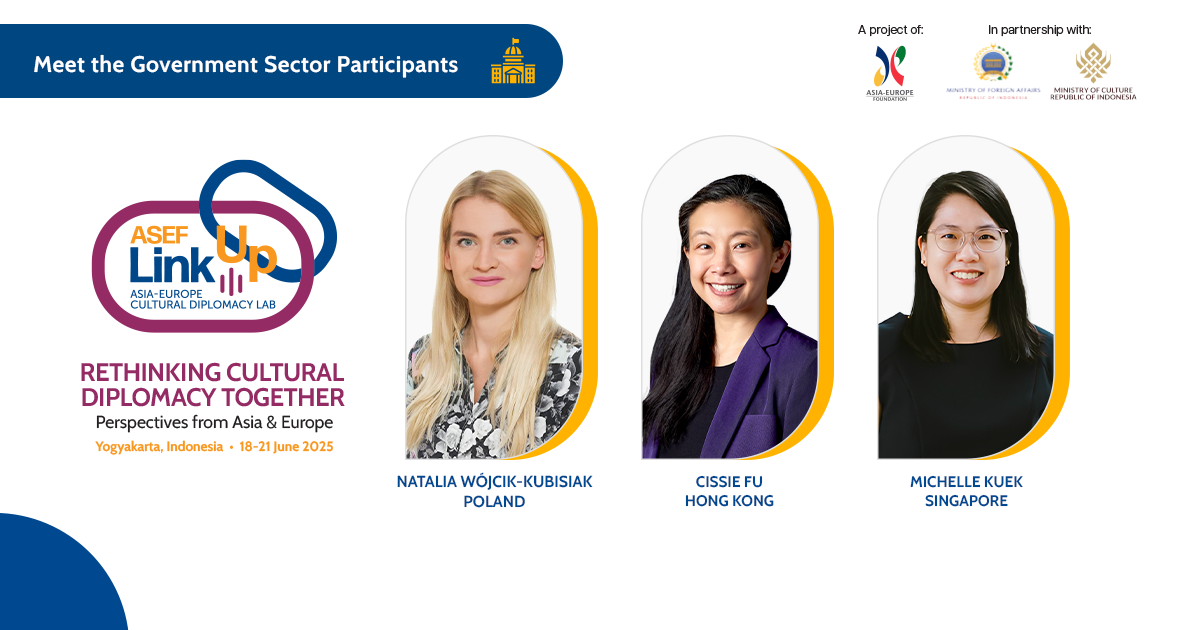ASEF LinkUp 2025 | Perspectives from the Government Sector

We are nearing the start of this year’s ASEF LinkUp | Asia-Europe Cultural Diplomacy Lab!
From 18 to 21 June, ASEF in partnership with the Ministry of Foreign Affairs and Ministry of Culture of Indonesia, with the support of the Yogyakarta Royal Palace, Regional Government of the Special Region of Yogyakarta, Sonobudoyo Museum, ArtJog Festival, UNESCO Jakarta and the European network on cultural management and policy, ENCATC, will gather 19 selected participants from the cultural and government sectors in Yogyakarta, Indonesia.
Introducing the nine government sector participants from China, Germany, Japan, Indonesia, Poland, Singapore and Thailand. The diversity of participants, spanning from cultural officers at ministries and embassies to representatives from cultural institutions, higher education institutions and museums share their insights on what is challenging about working collectively.
Infrastructural bottlenecks
Indonesia is a large archipelago, comprising a land area of more than one million km2 and over 10,000 islands. Given the geographical size of Indonesia, grappling with outreach across cities, islands and communities poses as a challenge. Not to mention that over 700 other native languages are spoken across the country and there are significant gaps between traditional and contemporary artists, urban and rural practices, formal institutions and independent communities, shares Dicki Armawanto, who works at the Cultural Office of Special Region of Yogyarkata.
This was a sentiment echoed by Matthias Ventker, the director of the Goethe-Institut Bandung. The geographical size of Indonesia meant that two Goethe-Instituts had to be established on Java Island itself.
Being aware of the internal diversity and nuances of each context will allow us to contribute meaningfully to cultural diplomacy. How can policies and programmes be framed as inclusive as possible, to tackle inequalities of access to resources, opportunities and participation in international cultural cooperation?

Aligning top-down policy with grassroots needs
From the perspectives of those in the Ministry of Foreign Affairs and Ministry of Culture of Indonesia, the challenge in nurturing the connections between the arts sector and governmental representatives lies in understanding the disconnect between organisational and grassroot interest.
At a governmental level, many programmes that are being funded are often embedded with higher-level political or economic objectives. While this is not necessarily a bad thing, these high-level agendas need to be communicated to help the arts sector align proposals with community needs and government policy aims.
There is hence a strong need to find a good balance between the government needs and expectations and the wishes and expectations of those on the ground – a key area that ASEF LinkUp aims to address.

Short-term thinking, long-term impact
The one-off funding that is largely available to the sector and growing emphasis on short-term outcomes is an ongoing challenge faced by both the arts and government sector participants.
‘This makes it challenging to effectively communicate the long-term significance and impact of cultural exchange programmes, which often require sustained engagement to achieve meaningful results.’ - Mari Shogase, director of Arts and Culture Department at the Japan Foundation, Bangkok
In addition, international cultural exchanges have always necessitated grasping and embracing cultural differences.
‘The difference in values, beliefs and (economic) backgrounds of peoples from different countries are quite challenging.’ - Shayanid Prasertpol, a diplomat from the Ministry of Foreign Affairs, Thailand
Given the type of challenges that we are up against today – the climate crisis, geopolitical tensions, digital shift and more, knowing how to orientate oneself to be observant and self-aware of cultural differences, becomes more critical than ever
‘Building trust and aligning goals takes time, especially when navigating different cultural norms, communication styles, and organisational priorities.’ - Natalia Wójcik-Kubisiak, cultural officer at the Embassy of Poland in Jakarta
Can opportunities for the sector be made more intentional? Focusing instead on creating time and space to invest in the development of cultural, sociopolitical and artistic understanding for international collaborations and partnerships could be more beneficial.

Building structures of collaboration that work for everyone
It is clear that those in the arts and culture sector work within a multidimensional framework.
‘Representatives from individual and overlapping sectors can and should all (be invited to) contribute to holistic discussions about the political economy of creativity and cultural production.’ - Dr Cissie Fu, Head of the McNally School of Fine Arts at LASALLE College of the Arts
The narrative of cultural diplomacy should hence transition from a transactional, top-down approach towards a more participatory, co-creating and co-ownership model. This reaffirms the reflections and discussions by the participants of ASEF LinkUp 2024.
The digital divide: opportunity or obstacle?
The growth of the digital realm has added an additional layer of complexity when thinking about international cultural relations. Considering the diverse slate of traditional and social media platforms today, ‘each platform tends to attract specific age demographics, necessitating strategic decision-making and careful allocation of resources to effectively reach desired audiences.’ says Michelle Kuek, the Partnerships Lead at the National University of Singapore (NUS) Museum.
'As attention spans have become more fragmented, with a preference for short-form content. This trend often necessitates condensing artistic expressions into brief keywords and visuals, which can dilute the richness and depth of the original artistic output.’ - Michelle Kuek, Partnerships Lead at NUS Museum
The rise of digital engagement entails a rethinking of cross-border cultural relations. Such a shift could potentially reproduce or reinforce broader divides between different socio-economic groups, genders, age, urban and peripheral areas etc, in addition to distorting artistic visions. Yet, with sufficient advocacy and awareness-raising, it could also open doors for more balanced relations, especially where logistical and structural barriers are present.
Thinking ahead
What emerges from both the government and arts sector participants’ insights is a shared consensus that the current system requires some rethinking. International cultural cooperation must move beyond a transactional approach towards more intentional, participatory and horizontal collaborations.
In the coming weeks, the third edition of ASEF LinkUp | Asia-Europe Cultural Diplomacy Lab hopes to offer key perspectives and points of attention, while considering how the concept of “gotong royong”, the Indonesian concept of mutual cooperation and support can devise balanced, fair and long-term cultural relations.
Follow more conversations on #ASEFLinkUp on ASEF culture360's social media channels - Facebook, X and Instagram.
